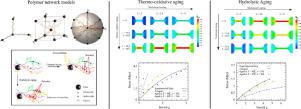当前位置:
X-MOL 学术
›
Int. J. Mech. Sci.
›
论文详情
Our official English website, www.x-mol.net, welcomes your feedback! (Note: you will need to create a separate account there.)
A Physically-Based Model for Thermo-Oxidative and Hydrolytic Aging of Elastomers
International Journal of Mechanical Sciences ( IF 7.3 ) Pub Date : 2021-03-01 , DOI: 10.1016/j.ijmecsci.2020.106193 Amir Bahrololoumi , Hamid Mohammadi , Vahid Moravati , Roozbeh Dargazany
International Journal of Mechanical Sciences ( IF 7.3 ) Pub Date : 2021-03-01 , DOI: 10.1016/j.ijmecsci.2020.106193 Amir Bahrololoumi , Hamid Mohammadi , Vahid Moravati , Roozbeh Dargazany

|
Abstract A computationally efficient model is proposed to capture the loss of mechanical performance due to chemical aging that are formed as the competition of chain scission and cross-link formation/dissolution, such as thermo-oxidative aging or hydrolytic aging. The model should be considered an extension of our recent models [1, 2, 3] which further simplifies the matrix behavior based on the assumption of independence of environmental and mechanical damage. The model uses this assumption to reduce the necessary material parameters needed to model constitutive and inelastic behavior of elastomers during aging. To this end, the model can provide accurate predictions of the material performance with the significantly fewer number of fitting parameters. The model is relevant for all decay mechanisms formed by the occurrence of two simultaneous micro-mechanisms; (i) formation/reduction of the cross-links, and (ii) chain scission, both of which are present in thermo-oxidation and hydrolytic aging. Assuming the alteration of the chain density along the aging trajectory is identical to the peroxide cross-link density for thermo-oxidation, and the change of the average molecular weight for hydrolysis, the strain energy of polymer matrix can be rewritten as a function of deformation, deformation history, storage time and aging temperature. Next, the modified network alteration model is formulated for implementation into Finite Element (FE) simulations. The model is built on the presumption of homogeneous and consistent oxygen/water absorption and thus is mainly relevant for relatively thin samples exposed to environmental loads for a long time. The proposed model includes only six physically inspired material parameters. Thus, while it is computationally efficient, it shows good agreement with own experimental data, which performed on various range of accelerated aging temperatures and times. With respect to its computational efficiency, simplicity, accuracy, and interpret-ability, the model is the right choice for advanced implementations in FE programs.
中文翻译:

基于物理的弹性体热氧化和水解老化模型
摘要 提出了一种计算效率高的模型来捕获由于化学老化而导致的机械性能损失,化学老化是由于断链和交联形成/溶解的竞争而形成的,例如热氧化老化或水解老化。该模型应被视为我们最近模型 [1, 2, 3] 的扩展,它进一步简化了基于环境和机械损伤独立假设的矩阵行为。该模型使用此假设来减少对老化期间弹性体的本构和非弹性行为进行建模所需的必要材料参数。为此,该模型可以提供对材料性能的准确预测,而拟合参数的数量要少得多。该模型与由两个同时发生的微观机制形成的所有衰变机制相关;(i) 交联的形成/减少,以及 (ii) 断链,这两者都存在于热氧化和水解老化中。假设链密度沿老化轨迹的变化与热氧化的过氧化物交联密度相同,以及水解的平均分子量的变化,聚合物基体的应变能可以改写为变形的函数、变形历史、储存时间和老化温度。接下来,将修改后的网络变更模型制定为实施到有限元 (FE) 模拟中。该模型建立在均匀一致的氧/水吸收假设之上,因此主要与长时间暴露于环境负荷的相对薄的样品相关。提议的模型仅包括六个受物理启发的材料参数。因此,虽然它在计算上是有效的,但它与自己的实验数据显示出良好的一致性,这些数据在各种加速老化温度和时间范围内进行。就其计算效率、简单性、准确性和可解释性而言,该模型是 FE 程序中高级实现的正确选择。它在各种加速老化温度和时间范围内进行。就其计算效率、简单性、准确性和可解释性而言,该模型是 FE 程序中高级实现的正确选择。它在各种加速老化温度和时间范围内进行。就其计算效率、简单性、准确性和可解释性而言,该模型是 FE 程序中高级实现的正确选择。
更新日期:2021-03-01
中文翻译:

基于物理的弹性体热氧化和水解老化模型
摘要 提出了一种计算效率高的模型来捕获由于化学老化而导致的机械性能损失,化学老化是由于断链和交联形成/溶解的竞争而形成的,例如热氧化老化或水解老化。该模型应被视为我们最近模型 [1, 2, 3] 的扩展,它进一步简化了基于环境和机械损伤独立假设的矩阵行为。该模型使用此假设来减少对老化期间弹性体的本构和非弹性行为进行建模所需的必要材料参数。为此,该模型可以提供对材料性能的准确预测,而拟合参数的数量要少得多。该模型与由两个同时发生的微观机制形成的所有衰变机制相关;(i) 交联的形成/减少,以及 (ii) 断链,这两者都存在于热氧化和水解老化中。假设链密度沿老化轨迹的变化与热氧化的过氧化物交联密度相同,以及水解的平均分子量的变化,聚合物基体的应变能可以改写为变形的函数、变形历史、储存时间和老化温度。接下来,将修改后的网络变更模型制定为实施到有限元 (FE) 模拟中。该模型建立在均匀一致的氧/水吸收假设之上,因此主要与长时间暴露于环境负荷的相对薄的样品相关。提议的模型仅包括六个受物理启发的材料参数。因此,虽然它在计算上是有效的,但它与自己的实验数据显示出良好的一致性,这些数据在各种加速老化温度和时间范围内进行。就其计算效率、简单性、准确性和可解释性而言,该模型是 FE 程序中高级实现的正确选择。它在各种加速老化温度和时间范围内进行。就其计算效率、简单性、准确性和可解释性而言,该模型是 FE 程序中高级实现的正确选择。它在各种加速老化温度和时间范围内进行。就其计算效率、简单性、准确性和可解释性而言,该模型是 FE 程序中高级实现的正确选择。



























 京公网安备 11010802027423号
京公网安备 11010802027423号